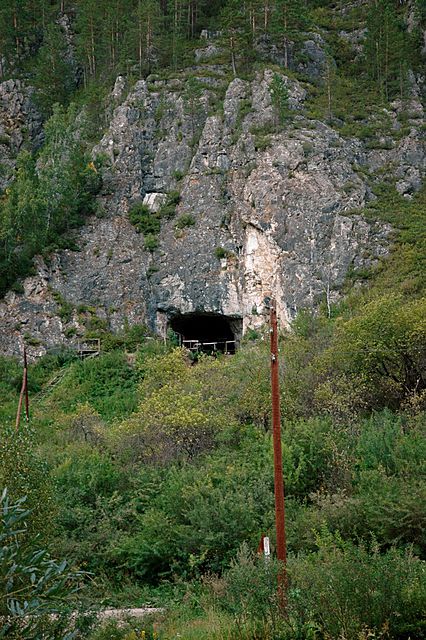
|
|
Denisova cave entrance in the Altai Mountains
of Siberia, Russia where the bones were found from which
DNA was sequenced
(Copyright (C) 2010, Johannes Krause)
|
Description
The Denisova track shows Denisova sequence reads mapped to the
human genome. The Denisova sequence was generated from a phalanx bone
excavated from Denisova Cave in the Altai Mountains in southern
Siberia.
Methods
Denisova sequence libraries were prepared by treating DNA extracted
from a single phalanx bone with two enzymes: uracil-DNA-glycosylase,
which removes uracil residues from DNA to leave abasic sites, and
endonuclease VIII, which cuts DNA at the 59 and 39 sides of abasic
sites. Subsequent incubation with T4 polynucleotide kinase and T4 DNA
polymerase was used to generate phosphorylated blunt ends that are
amenable to adaptor ligation. Because the great majority of uracil
residues occur close to the ends of ancient DNA molecules, this
procedure leads to only a moderate reduction in average length of the
molecules in the library, but a several-fold reduction in
uracil-derived nucleotide misincorporation. Reads were aligned
to human sequence Mar. 2006 (NCBI36/hg18) using the
Burrows-Wheeler Aligner.
Download the
Denisova track data sets from the Genome Browser downloads server.
References
Briggs A.W., Stenzel U., Meyer M., Krause J., Kircher M., Pääbo S.
Removal of deaminated cytosines and detection of in vivo
methylation in ancient DNA.
Nucleic Acids Res. 2009 Dec 22:38(6) e87.
Reich D., Green R.E., Kircher M., Krause J., Patterson N., Durand E.Y., Viola B.,
Briggs A.W., Stenzel U., Johnson P.L.F. et al.
Genetic history of an archaic hominin group from Denisova Cave in Siberia.
Nature. 2010 Dec 23;468:1053-1060.
Credits
This track was produced at UCSC using data generated by the Max Planck
Institute for Evolutionary Anthropology.
|
|